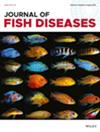Diving Into the Depths: Unveiling the Main Etiologies of Piscine Lactococcosis With a Novel Multiplex qPCR Assay
Abstract
Piscine lactococcosis poses a significant threat to a wide range of cultured and wild fish populations worldwide, typically presenting as acute haemorrhagic septicemia with high morbidity and mortality. Although Lactococcus garvieae was historically considered the sole causative agent of piscine lactococcosis, recent studies have identified L. petauri and L. formosensis as additional, highly pathogenic species. In this study, we developed a novel TaqMan-based multiplex qPCR assay for the simultaneous detection and differentiation of L. garvieae, L. petauri and L. formosensis, following a pangenome analysis of the publicly available genomes of these bacterial species. The assay demonstrated high sensitivity and specificity across 156 bacterial isolates obtained from various cultured fish species and geographical locations between 2008 and 2024, as well as against a panel of non-target bacteria. It also successfully detected target pathogens in 146 field tissue samples, including tissues preserved in 70% ethanol, formalin-fixed paraffin-embedded (FFPE) tissues and tissues fixed on FTA cards. Compared to classical bacteriology, the multiplex qPCR assay yielded higher detection rates and enabled precise identification of the causative species of piscine lactococcosis. Overall, the multiplex qPCR assay developed in this study provides a reliable, rapid, highly sensitive and species-specific molecular approach for diagnosing piscine lactococcosis, contributing to better surveillance and management of the disease in aquaculture.


 求助内容:
求助内容: 应助结果提醒方式:
应助结果提醒方式:


